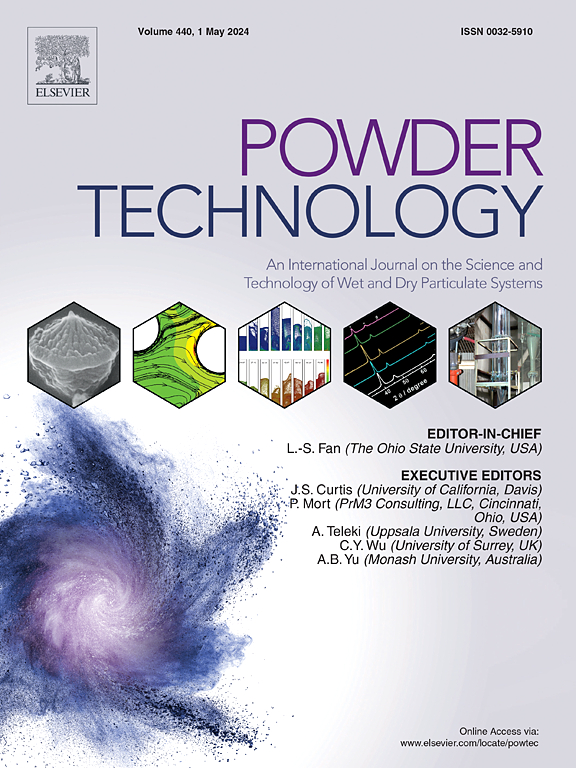结晶-过滤连续一体化工艺的优化设计
IF 4.5
2区 工程技术
Q2 ENGINEERING, CHEMICAL
引用次数: 0
摘要
工业结晶通常是通过过滤将固体颗粒从母液中分离出来,并且通常在结晶器和过滤器设计之间存在权衡:投资更多的钱在更大的结晶器上可以增加晶体尺寸并降低过滤成本。因此,过程仿真和优化对于确定这种集成过程的优化设计至关重要。然而,由于从晶体尺寸分布(CSD)估计蛋糕阻力的挑战,这种分析在文献中很少见。最近有人提出将Kozeny-Carman方程与离散元法(DEM)相结合来解决这一问题。在这项工作中,该方法被应用于优化连续集成结晶-过滤过程,包括那些通过产品分类或细粒去除来修改CSD的过程。结果表明,最佳设计取决于结晶动力学和浆料粘度。对于低成核率和低浆液粘度的体系,最佳设计是使结晶器成本最小化。对于高成核速率和高粘度的体系,需要一个严格的过程模型来确定最佳结晶器体积和细粒溶解剂的设计。本文章由计算机程序翻译,如有差异,请以英文原文为准。

Optimal design of continuous integrated crystallization-filtration processes
Industrial crystallization is typically followed by filtration to separate the solid particles from the mother liquid and there is often a tradeoff between crystallizer and filter design: Investing more money in a larger crystallizer can increase crystal size and lower filtration costs. Thus, process simulation and optimization are essential to identify the optimal design of such integrated process. However such analyses are rare in the literature due to challenges in estimating cake resistance from a crystal size distribution (CSD). Recently it has been proposed to address this issue by combining the Kozeny-Carman equation with the discrete element method (DEM).
In this work, this approach is applied to optimize continuous integrated crystallization-filtration processes including those where the CSD is modified by product classification or fines removal. Results show that the optimal design depends on crystallization kinetics and slurry viscosity. For systems with low nucleation rate and low slurry viscosity, the optimal design is to minimize the crystallizer cost. For systems with high nucleation rate and high viscosity, a rigorous process model is required to determine the optimal crystallizer volume and fines dissolver design.
求助全文
通过发布文献求助,成功后即可免费获取论文全文。
去求助
来源期刊

Powder Technology
工程技术-工程:化工
CiteScore
9.90
自引率
15.40%
发文量
1047
审稿时长
46 days
期刊介绍:
Powder Technology is an International Journal on the Science and Technology of Wet and Dry Particulate Systems. Powder Technology publishes papers on all aspects of the formation of particles and their characterisation and on the study of systems containing particulate solids. No limitation is imposed on the size of the particles, which may range from nanometre scale, as in pigments or aerosols, to that of mined or quarried materials. The following list of topics is not intended to be comprehensive, but rather to indicate typical subjects which fall within the scope of the journal's interests:
Formation and synthesis of particles by precipitation and other methods.
Modification of particles by agglomeration, coating, comminution and attrition.
Characterisation of the size, shape, surface area, pore structure and strength of particles and agglomerates (including the origins and effects of inter particle forces).
Packing, failure, flow and permeability of assemblies of particles.
Particle-particle interactions and suspension rheology.
Handling and processing operations such as slurry flow, fluidization, pneumatic conveying.
Interactions between particles and their environment, including delivery of particulate products to the body.
Applications of particle technology in production of pharmaceuticals, chemicals, foods, pigments, structural, and functional materials and in environmental and energy related matters.
For materials-oriented contributions we are looking for articles revealing the effect of particle/powder characteristics (size, morphology and composition, in that order) on material performance or functionality and, ideally, comparison to any industrial standard.
 求助内容:
求助内容: 应助结果提醒方式:
应助结果提醒方式:


